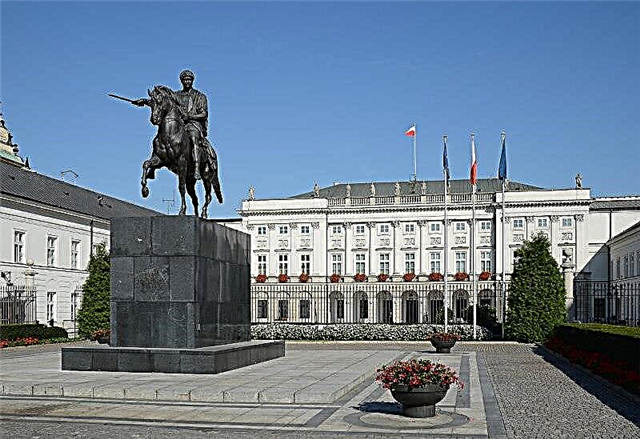Address: Russia, Moscow, st. Bolshaya Ordynka
Foundation date: 1909 year
Main attractions: Cathedral of the Intercession of the Most Holy Theotokos, Church of Martha and Mary at the hospital building, chapel of Elizabeth Feodorovna, monument to Grand Duchess Elizabeth Feodorovna
Shrines: Ark with a particle of the relics of the holy prmts of the Grand Duchess Elizabeth Feodorovna, the reliquary with a particle of the relics of the holy prmts Barbara, the Ark with a particle of the relics of the holy prmch Sergius (Srebryansky), a particle of the relics of the Monk Confessor Gabriel (Igoshkin)
Coordinates: 55 ° 44'15.5 "N 37 ° 37'23.3" E
Cultural heritage site of the Russian Federation
Content:
For more than a hundred years one of the monasteries in Moscow has been supporting the sick and the poor, the disabled and orphans. Today, over 20 branches of the Martha and Mary Convent have been opened in different parts of our country. All of them, like the monastery itself, lend a helping hand to everyone who needs it.

Marfo-Mariinsky Convent from a bird's eye view
How the monastery was created
Many great beginnings have come from extraordinary personalities. The history of the Moscow monastery confirms this rule. The traditions of the unusual monastery were laid down by the ascetic work of the Grand Duchess Elizabeth Feodorovna.
By the beginning of the last century, revolutionary groups became more active in the Russian Empire, and there was an increase in radical sentiments. In 1904, Ivan Kalyaev, a terrorist and member of the Combat Organization of the Social Revolutionaries, took part in the assassination attempt on the Minister of Internal Affairs of Russia Vyacheslav Pleve. And in February 1905, he entered the Kremlin and threw a bomb at Grand Duke Sergei Alexandrovich.
The emperor's brother was killed on the spot, and Kaliayev was detained by a police outfit. The widow of the Grand Duke was very sad about the loss, but she visited the terrorist in prison, forgave him and left the Gospel to Kaliayev. Then she wrote a petition to the emperor and asked him to pardon. But Nicholas II did not agree, and by a court decision in May 1905, Kalyaev was hanged in the Shlisselburg fortress.

The gate to the monastery from st. Bolshaya Ordynka
Having lost her spouse and left alone, Elizaveta Fedorovna could no longer continue her former social life. She sold her property and acquired a large estate in the center of Moscow. In 1909, a new convent was established in four buildings with a garden.
The Grand Duchess decided to name it in honor of two saints, who became the embodiment of the purity of the Christian path among believers around the world. Martha and Mary, the sisters of Lazarus, dedicated themselves to love and fervent prayer, and therefore they were venerated by both Orthodox and Catholics.
The fate of the monastery in the XX century
The Grand Duchess wanted the monastery to adopt not only the Russian experience of monasticism, but also to absorb the best traditions of foreign monasteries. In addition, she dreamed that women priests or deaconesses would appear in our churches.

Cathedral of the Intercession of the Holy Virgin
Elizaveta Fyodorovna cared much about the introduction of the rank of deaconesses and even received the approval of the conservative Holy Synod for innovations. The Russian Orthodox Church was ready for women priests to serve in parishes. They could baptize other women, lead church services, and help the sick. However, the emperor opposed the innovation, and the decision was never made.
Whereas in other monasteries the nuns led a reclusive life, in the new monastery the nuns helped in hospitals and did charity work. In order for them to carry out their work more professionally, the Grand Duchess attracted the best Moscow doctors to the training of novices, and they taught the nuns the basics of nursing and competent care for the sick.
The doors of the monastery were always open. Spiritual readings were held here, and members of the Palestinian Orthodox and Geographical Society gathered. The new monastery was distinguished by the fact that the sisters were not chained to it forever. According to the charter, after a certain period of time, they had the right to return to ordinary life.

View of the northern facade of the Cathedral of the Intercession of the Most Holy Theotokos
The Grand Duchess lived constantly within the walls of the monastery. Her days were busy with prayer and hospital work. During the First World War, she, along with other nuns, raised money for the front and helped the wounded. For several years, the monastery managed to complete whole trains and send food, medicine and dressings to the front line.
Two years after the outbreak of the war, the number of disabled Russians increased, and the need for prosthetics arose. The founder of the monastery collected donations and began to build a plant for the manufacture of prostheses. It is interesting that this company operates to this day and, just like a century ago, produces components for prostheses.
With the advent of Soviet power, monastery life changed dramatically. In a short time, the Bolsheviks tried to get rid of all members of the royal family and other noble Russians. The Grand Duchess was captured and sent to the Perm province. There, a 53-year-old woman was thrown alive into a spent mine near Alapaevsk. Together with her, seven more people died.

Monument to Grand Duchess Elizabeth Feodorovna
The cloister was closed in 1926, when more than 100 nuns lived there. Until 1928, a polyclinic operated on the territory of the monastery. Then the remaining sisters were evicted from the monastery. Some of them ended up in exile in the Turkestan steppes, while others ended up in the Tver province.
After the final liquidation of the monastery, the cathedral building was turned into a cinema, and then lectures on health education began to be held here. In the post-war period, restoration workshops were located in one church, and an outpatient clinic was kept in the other. The monastery was returned to the faithful in the early 1990s, and the cathedral church was returned to the church in 2006.
Museum
The monastery's museum exposition is dedicated to Elizabeth Feodorovna and the history of the monastery. Twice a day, tourists and pilgrims are taken on excursions from the Intercession Cathedral. They are shown the rooms of the Grand Duchess, in which the atmosphere of the beginning of the last century is preserved. Here you can see the personal icons of Elizabeth Feodorovna, her embroidery, an old piano, a kitchen service, portraits, documents and old photographs.

In the center of the southeastern gate and the chapel of Seraphim of Sarov
The current state of the monastery
For several years now, the convent has had the status of a stauropegic. 30 women live here. Sisters serve hospice and help terminally ill children, work in a cafeteria created for the poor, and work in military hospitals.
They teach in a gymnasium, maintain an orphanage for orphans and a medical center that provides assistance to patients with infantile cerebral palsy. Nuns who live in other branches of the monastery are required to undergo training in Moscow.
The Moscow monastery hosts courses for pregnant women and classes at a school for foster parents. Day groups have been created here, where children with developmental problems are taken, and a lecture hall on church history has been opened. The volume of work that the monastery does cannot be completed by the efforts of 30 nuns, therefore, the monastery attracts volunteers for certain projects.

Chapel of Elizabeth Feodorovna
Monastic buildings
The monastery area is small, but very intelligently organized. Here, without disturbing others, you can freely breathe fresh air in the gazebo or take a walk with your child in the playground. Small paths laid through the monastery resemble English gardens, and the monastery is decorated with an expressive monument to Elizabeth Feodorovna.
The cathedral church was designed by the famous architect Alexei Shchusev and erected in 1912.The architect managed to achieve harmony between the Art Nouveau style popular at that time and the traditions of Old Russian church architecture. The interior paintings in the church were made by talented Russian painters Mikhail Vasilyevich Nesterov and Pavel Dmitrievich Korin.
The Church of the Intercession is small in size and can accommodate up to 1000 people. 12 bells hang on its belfry, and their sound is very similar to the famous ringing of Rostov the Great.
Nearby there is a temple dedicated to Mary and Martha. It was erected in 1909 and for a long time served as the home church at the hospital. The Martha-Mariinsky Church was designed so that bedridden patients could observe the progress of church services.

Wall fountain
In addition to two churches, the monastery has a small chapel dedicated to the founder of the monastery. There is also a one-storey gardener's house and a gatehouse with a chapel in honor of Seraphim of Sarov.
How to get there
The territory of the monastery is located on Bolshaya Ordynka Street, 2 km south of the Moscow Kremlin. The monastery can be reached on foot from the Tretyakovskaya and Polyanka metro stations in 10 minutes. The nearest public transport stops are located on Bolshaya Polyanka and Bolshaya Ordynka streets. They can be reached by buses No. 8, M5, M6 and K.











